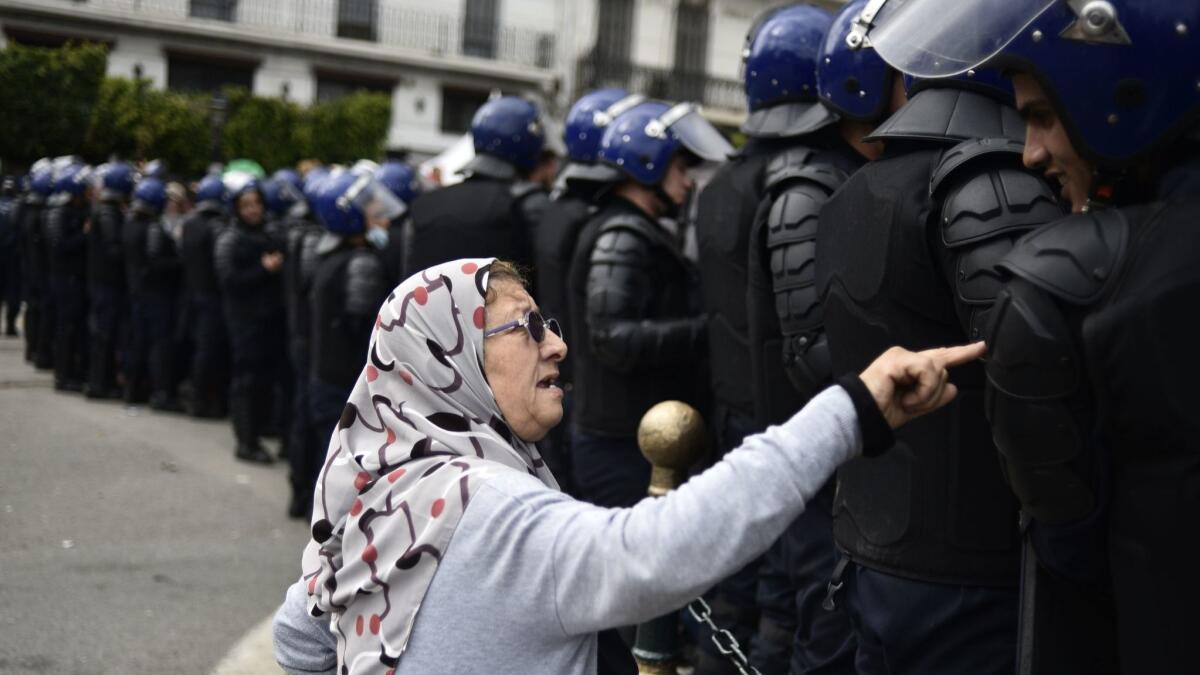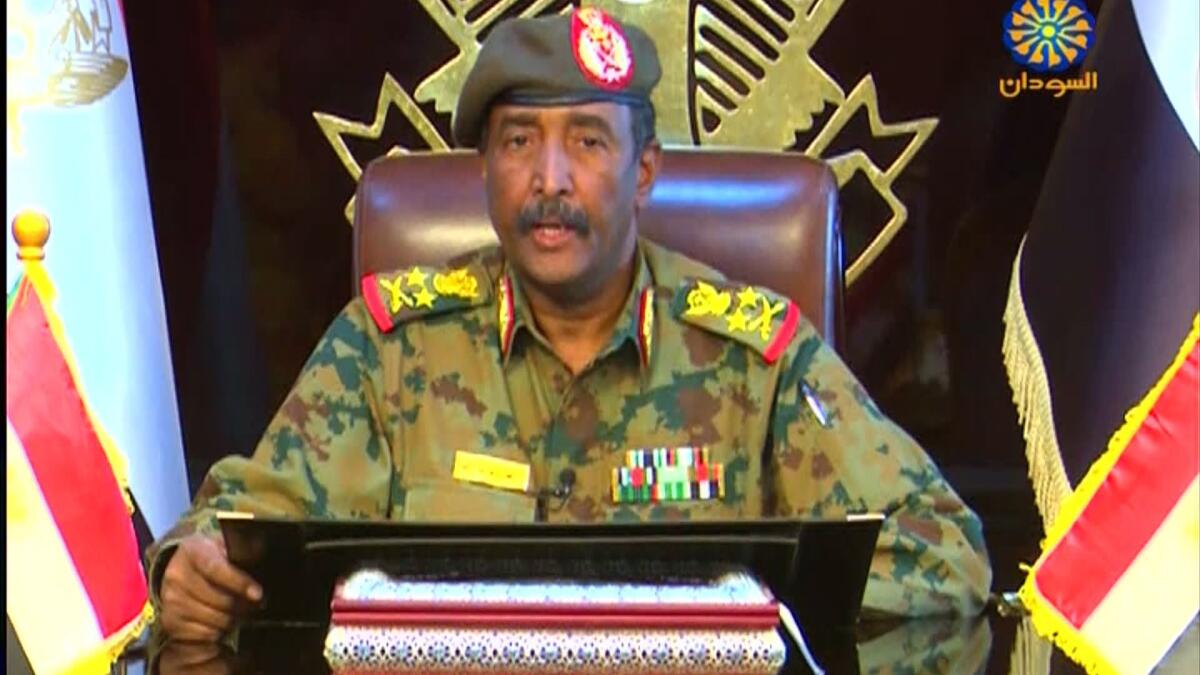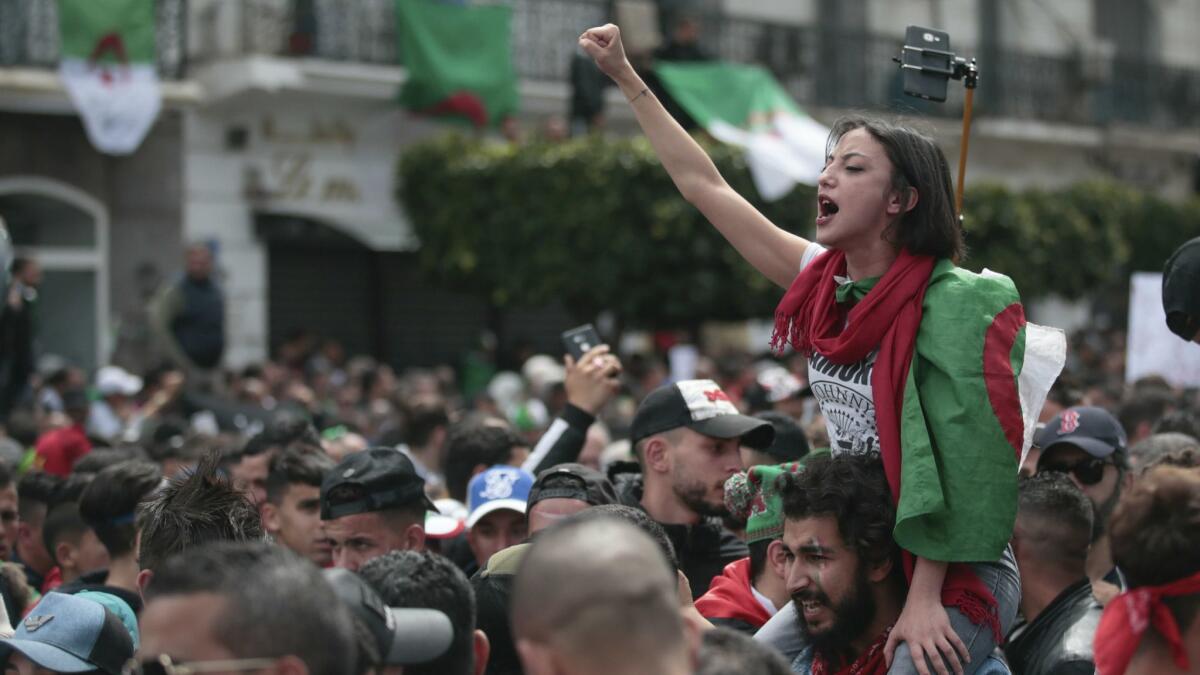How the military piggybacked on populist uprisings in Algeria and Sudan

- Share via
Reporting from Beirut — Within the last two weeks, protests that are being called “Arab Spring 2.0” have led to the fall of presidents in Algeria and Sudan. But these aren’t just people’s revolutions: In both cases, the army stepped in, purportedly in support of the anti-government demonstrators.
In Algeria, a general removed a figurehead president and now claims to side with protesters. In Sudan, the defense minister arrested his boss and put the army in charge for two years to “safeguard the revolution.” Then, on Friday, he stepped down and named a general as the country’s interim leader.
Meanwhile, in nearby Libya, a general has mounted an assault on the capital in an effort to wrest it from the struggling civilian government.
The protest-backed coups in Algeria and Sudan are reminiscent of the original Arab Spring revolutions of 2011, which toppled governments in Tunisia, Egypt, Libya and Yemen, and led to civil war in Syria. But, with the possible exception of Tunisia, there have been no happy endings — and even Tunisia suffers from a chronically embattled government.
In Egypt, the demonstrations led to the overthrow of an autocratic president, Hosni Mubarak, and the democratic election of an Islamist leader, Mohamed Morsi.
But when Morsi himself became the target of mass protests, the army stepped in and installed Gen. Abdel Fattah Sisi as president in 2013. Sisi, initially celebrated by demonstrators, has proved to be at least as autocratic as Mubarak.
That’s a scenario that many across North Africa fear, even as they look to avoid a confrontation with the army and the ensuing bedlam that were the legacy of the 2011 uprisings in Syria, Libya and Yemen.
Yet the parallels are unmistakable.
Libya’s Khalifa Haftar, a career soldier, is mired in a difficult offensive to seize the capital, Tripoli, and take the place of former strongman Moammar Kadafi.
Lt. Gen. Ahmed Gaid Salah, the Algerian army’s chief of staff, is working to preserve “Le Pouvoir” (the Power) of political, business and military apparatchiks who have ruled the country for decades.
Sudanese Defense Minister Awad Ibn Auf installed a military council after deposing President Omar Bashir, ending Bashir’s 30-year rule and placing himself as head of the military council.
Ibn Auf ended up ruling for 30 hours. On Friday, he installed Lt. Gen. Abdel Fattah Abdelrahman Burhan as leader, even as the military promised to return the country to civilian rule soon.

“There’s definitely an effort on the part of the old regimes to maintain power, just as we saw in the previous rounds of uprisings in Egypt and elsewhere,” said Timothy Kaldas, a nonresident fellow at the Tahrir Institute for Middle East Policy, in a phone interview on Friday.
But just as the region’s authoritarian governments have taken lessons from their experience in 2011, Kaldas said, “the people organizing these uprisings have learned a great deal as well.”
“From Khartoum to Algiers, you hear protesters saying they don’t want another Sisi, more military rule. They want a removal of the regime, not just its leader or figurehead,” Kaldas said.
Some of those lessons were on display on Friday, when Algerians came out en masse for an eighth consecutive week, this time to protest against the appointment of Abdelkader Bensalah, leader of the upper house of parliament, as the country’s interim president and rejecting his plan (with Salah backing him) to hold elections in July.

Riot police bristling with truncheons and protective gear tried to block the deluge of people walking along the major boulevards of Algiers, the capital, activists said, before finally giving in and letting them pass.
Videos uploaded by a local news website, Algeria 24, depicted one protester hugging a line of police officers, many of whom had lowered the heavy visors covering their faces to return the embrace.
But there was also violence. The country’s Directorate General for National Security said 83 police officers had been wounded and 180 people were arrested. Protesters said police used tear gas.
And overnight in Khartoum and other cities in Sudan, protesters remained in the streets, in defiance of the military imposing a curfew from 10 p.m. to 4 a.m.
The Sudanese Professionals’ Assn., a group of doctors, lawyers, engineers and others who had come out in support of the uprisings, released a statement on Friday for all to peacefully resist the military’s plans, even as protesters shouted a slogan, “Either victory or Egypt,” in reference to Sisi’s rise to power.
“The coup … makes the country liable to repeat the farce it witnessed in the last 30 years,” the statement said. “How can the regime feel no shame in trying to pick the fruit they were just yesterday trying to exterminate?”
But although those words and protests were inspirational, the military and the old guard have already begun to reassert themselves, said Jalel Herchaoui, a research fellow at the Clingendael Institute in The Hague.
“You look at all those beautiful Fridays in Algeria and say, ‘This is fantastic, we’re obviously moving toward democracy’ — but that’s not at all what is happening,” Herchaoui said in a phone interview on Friday.
In both Algeria and Sudan, he said, “the military has centralized much more power today compared to a few months ago.”
And, like the 2011 uprisings, Herchaoui said, other governments in the region, fearing their own restive populations, are getting involved and using the same playbook.
By last year, many of those governments could breathe a little easier. They had weathered the Arab Spring in 2011, subduing their populations with the specter of the bloodbaths in Syria and Libya.
The oil-rich Persian Gulf fiefdoms, meanwhile, had taken advantage of the uprisings, which had removed geriatric, deeply unpopular leaders only to reincarnate autocratic states headed by strongmen like Sisi, who were even more amenable to their policies and petrodollar-fueled influence.
For Saudi Arabia and the United Arab Emirates, the new incarnation of the Arab Spring “was an opportunity, not a threat,” Herchaoui said.
Meanwhile, Western nations, wary of the post-2011 turmoil that brought the rise of Islamic State in Syria and Iraq, and millions of refugees to Europe’s shores, appear likely to fall in line, despite their lip service in support of democratic reform.
That appears to be the case in Libya.
After 2011, the country splintered into a chaotic jumble of militias that eventually coalesced around two major authorities. One is an internationally recognized government in Tripoli. The other is based in the eastern part of the country, with Haftar as its top military commander.
The UAE and France had long given Haftar the weapons, materiel and air power to pursue successive campaigns in the country, even as they orchestrated diplomatic support for him among Western nations.
Last week, he used those same resources to mount an assault on Tripoli, in effect torpedoing efforts of the last two years to hold a peace conference among Libya’s warring parties set for later this month.
ALSO
From her atelier in Cairo, she dresses belly dancers from around the world
In a vast, dust-swept landscape, Islamic State caliphate ends in rubble and wreckage
More to Read
Sign up for Essential California
The most important California stories and recommendations in your inbox every morning.
You may occasionally receive promotional content from the Los Angeles Times.











